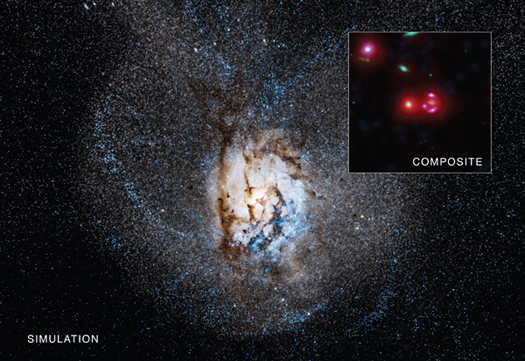Super Starburst Galaxy Found One Billion Years After the Big Bang

Jingzhe Ma
We are pleased to welcome Jingzhe Ma as a guest blogger. She is the first author of a paper that is the subject of our latest press release. Jingzhe is a PhD candidate at the University of Florida, working with Prof. Anthony Gonzalez and Prof. Jian Ge. She is going to defend her PhD dissertation next summer. She has been working on the formation and evolution of high-redshift dusty galaxies through multi-wavelength observations. She joined the South Pole Telescope Sub-Millimeter Galaxy (SPT SMG) Collaboration led by Prof. Joaquin Vieira in 2012.
When Prof. Anthony Gonzalez first introduced me to the SPT SMG group, I was fascinated by the sub-millimeter galaxies discovered by the South Pole Telescope, which is located at the geographic South Pole. We call them sub-millimeter galaxies because these galaxies were historically first discovered at sub-millimeter wavelengths (slightly shorter than one millimeter). They are bright at these wavelengths but very faint in the visible wavelengths due to the large amount of dust in these galaxies. Dust plays an important role, by absorbing and scattering the ultraviolet and visible light from newborn stars. The dust gets heated and re-radiates light in the infrared. I was interested in further studying these objects not only because these galaxies are forming stars at tremendous rates and have revolutionized our understanding of galaxy evolution, but also because these galaxies are magnified by massive foreground galaxies, which act as a gravitational lens. “Wearing” a gravitational lens, we are able to see better.
Among all the galaxies in this sample, one drew our special attention: SPT0346-52. It is the most luminous galaxy in our sample and relatively small in size. SPT0346-52 has been observed from optical to radio with the Hubble Space Telescope, the Spitzer Space Telescope, the Herschel Space Telescope, the Atacama Large Millimeter/submillimeter Array, the Very Large Telescope, the Atacama Pathfinder Experiment, the South Pole Telescope, and the Australia Telescope Compact Array. SPT0346-52 gives off a tremendous amount of infrared light, which implies its rate of star formation is about 4,000 times that of our Milky Way galaxy.
A critical question arises: Does all the infrared light originate from star formation? We were skeptical because we hadn’t seen a galaxy like this at such an early stage of the Universe. Also, SPT 0346-52 does not look like a typical sub-millimeter galaxy. We often see hot dust in a galaxy that contains a supermassive black hole but the dust temperature of SPT0346-52 is higher than that of typical sub-millimeter galaxies. We suspected that SPT0346-52 might harbor an actively growing supermassive black hole that was instead producing much of the infrared emission.
We were motivated to use the Chandra X-ray Observatory to look for a potential growing supermassive black hole since it is the best way to show the existence of such an object. I remember my reaction vividly when I got the data in hand. I was expecting to see some X-ray photons from the galaxy and prove that the galaxy does contain a growing supermassive black hole. That would make life easy for me because it would be the most straightforward explanation: part of the light originates from the dusty torus around the supermassive black hole and rest of the light arises from stars. That would not be that crazy.
My reaction instead was: “What?! Almost nothing there?!” The data was like a slap in my face. I was very disappointed at first, then almost immediately after that I was thrilled. I realized that if a black hole is not contributing to the huge infrared luminosity we see, then SPT0346-52 is confirmed to be an extreme starburst galaxy only one billion years after the Big Bang. I processed the data many times and the results were the same. I could only put an upper limit on the brightness of the X-ray emission.
However, this was not the end of the story. What if there does exist an actively growing supermassive black hole but we just do not see it in X-rays? This is actually possible in the rare case of extremely large amounts of gas and dust that even X-rays cannot penetrate easily. At this point, I could not say for sure that SPT0346-52 is not powered in the infrared by a growing black hole. Is part of the infrared luminosity contributed by a growing supermassive black hole, if any?
To gain further insight, I next used the spectral energy distribution fitting technique, which astronomers developed to compare the observed brightness at different wavelengths to models. It turned out that including a growing supermassive black hole in the model contradicts the observed data and a purely star-forming galaxy best explains what we observed. We looked at radio data of SPT0346-52 from the Australia Telescope Compact Array and did not see any evidence for the presence of a growing black hole, which further assured us that the star formation rate is truly exceptional. Large reservoirs of gas and a high efficiency in converting gas to stars could result in such a high rate of star formation. What triggered that in the first place remains a mystery with the current observations. The James Webb Space Telescope to be launched in 2018 should uncover the veil.
The entire SPT SMG group has been working hard to obtain more data to fulfill our curiosity and better understand how these galaxies form and evolve. It has been a good experience collaborating with these highly motivated people. I think being motivated by pure curiosity and putting great effort into pursuing truth is one of the happiest and luckiest things a person can experience.
As a side note just for entertainment, I don’t know exactly how but SPT0346-52 made its way to one of the episodes of The Big Bang Theory show!
Category:
- Log in to post comments

